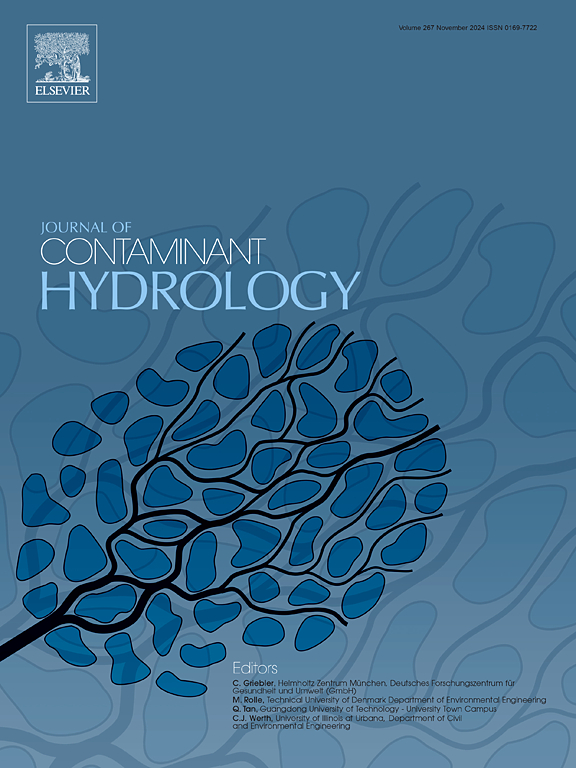Geochemical behavior of amended and non-amended mine tailings as cover materials for acid mine drainage control: Column tests and reactive transport modeling
IF 3.5
3区 环境科学与生态学
Q2 ENVIRONMENTAL SCIENCES
引用次数: 0
Abstract
Mining companies generate large volumes of waste rock and tailings every year. To reduce these volumes, mining companies can valorize them as construction materials for cover systems such as cover with capillary barrier effects (CCBE). However, questions remain related to the geochemistry of the leachate that percolates through CCBEs made from mining materials. Limestone amendment can be used for increasing the neutralizing potential (NP) of mining materials in the case where the materials have a risk to generate contaminants. This study aims at assessing the performance of low-sulfide tailings, amended or not, and non-acid generating waste rock as components of CCBEs. To do so, five column tests were conducted in the laboratory to assess the long-term geochemical evolution of waste-rock, low-reactive tailings (2 % pyrite), tailings amended with 8 wt% of limestone, CCBE with the moisture-retaining layer (MRL) made of low-reactive tailings (CCBE-T), and CCBE with the MRL made of amended tailings (CCBE-TA). The geochemical evolution of leachates from the different column tests was simulated with MIN3P, a multicomponent reactive transport model. The numerical model was calibrated using results from the column tests. Long-term simulations using the short-term calibrated models suggested that low-reactive tailings could produce AMD when exposed to laboratory conditions, while limestone amendments effectively neutralized the generated acidity and stabilized the pH. Furthermore, incorporating tailings as a MRL in a CCBE reduced sulfide oxidation in the long-term due to the high degree of saturation that limited oxygen diffusion and sulfide reactivity.
作为酸性矿山排水控制覆盖材料的修正和非修正矿山尾矿的地球化学行为:柱试验和反应迁移模型
矿业公司每年产生大量的废石和尾矿。为了减少这些体积,矿业公司可以将其作为覆盖系统的建筑材料,例如具有毛细管屏障效应的覆盖(CCBE)。然而,问题仍然与通过由采矿材料制成的CCBEs渗透的渗滤液的地球化学有关。石灰石改进剂可用于增加采矿材料的中和电位(NP),在材料有产生污染物的风险的情况下。本研究旨在评估低硫化物尾矿(无论改性与否)和不产酸废石作为CCBEs组分的性能。为此,在实验室进行了5个柱试验,以评估废岩、低活性尾矿(2%黄铁矿)、8 wt%石灰石改性尾矿、低活性尾矿(CCBE- t)组成的防潮层(MRL) CCBE和改性尾矿(CCBE- ta)组成的CCBE的长期地球化学演化。采用多组分反应输运模型MIN3P模拟不同柱试渗滤液的地球化学演化过程。数值模型使用柱试验的结果进行校准。使用短期校准模型进行的长期模拟表明,低活性尾矿暴露在实验室条件下会产生AMD,而石灰石修正剂有效地中和了产生的酸度并稳定了ph。此外,由于高饱和度限制了氧扩散和硫化物反应性,在CCBE中加入尾矿作为MRL,从长期来看可以减少硫化物氧化。
本文章由计算机程序翻译,如有差异,请以英文原文为准。
求助全文
约1分钟内获得全文
求助全文
来源期刊

Journal of contaminant hydrology
环境科学-地球科学综合
CiteScore
6.80
自引率
2.80%
发文量
129
审稿时长
68 days
期刊介绍:
The Journal of Contaminant Hydrology is an international journal publishing scientific articles pertaining to the contamination of subsurface water resources. Emphasis is placed on investigations of the physical, chemical, and biological processes influencing the behavior and fate of organic and inorganic contaminants in the unsaturated (vadose) and saturated (groundwater) zones, as well as at groundwater-surface water interfaces. The ecological impacts of contaminants transported both from and to aquifers are of interest. Articles on contamination of surface water only, without a link to groundwater, are out of the scope. Broad latitude is allowed in identifying contaminants of interest, and include legacy and emerging pollutants, nutrients, nanoparticles, pathogenic microorganisms (e.g., bacteria, viruses, protozoa), microplastics, and various constituents associated with energy production (e.g., methane, carbon dioxide, hydrogen sulfide).
The journal''s scope embraces a wide range of topics including: experimental investigations of contaminant sorption, diffusion, transformation, volatilization and transport in the surface and subsurface; characterization of soil and aquifer properties only as they influence contaminant behavior; development and testing of mathematical models of contaminant behaviour; innovative techniques for restoration of contaminated sites; development of new tools or techniques for monitoring the extent of soil and groundwater contamination; transformation of contaminants in the hyporheic zone; effects of contaminants traversing the hyporheic zone on surface water and groundwater ecosystems; subsurface carbon sequestration and/or turnover; and migration of fluids associated with energy production into groundwater.
 求助内容:
求助内容: 应助结果提醒方式:
应助结果提醒方式:


